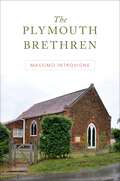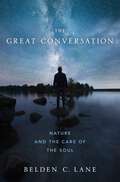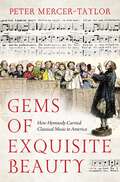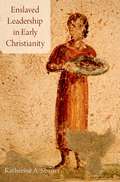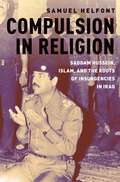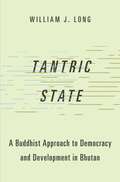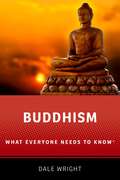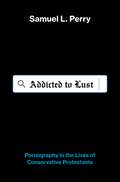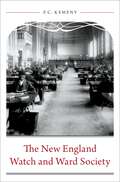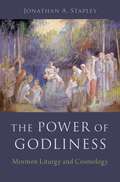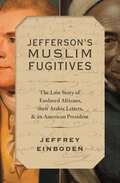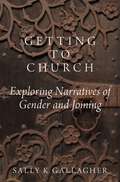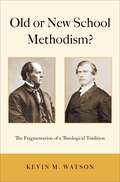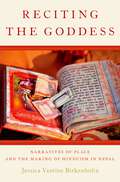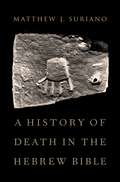- Table View
- List View
The Plymouth Brethren
by Massimo IntrovigneThis is the first history of the Plymouth Brethren, a conservative, nonconformist evangelical Christian movement whose history can be traced to Dublin, Ireland in the late 1820s. The teachings of John Nelson Darby, an influential figure among the early Plymouth Brethren, have had a huge impact on modern evangelicalism. However, the credit for Darby's work went to some of the first generation of his students, and as evangelicalism has grown it has completely ignored its origins in Darby and the Brethren. In this book, Massimo Introvigne restores credit to John Nelson Darby and his movement, and places them in a contemporary sociological framework based on Introvigne's participant observation in Brethren communities. The modern-day Plymouth Brethren emphasize sola scriptura, the belief that the Bible is the supreme authority for church doctrine and practice. Brethren see themselves as a network of like-minded independent assemblies rather than as a church or a denomination. The movement has also refused to take any formal denominational name; the title "the Brethren" comes from the Biblical passage "one is your Master, even Christ; and all ye are brethren" (Matthew 23:8). The Plymouth Brethren offers a typology of differing branches of this reclusive movement, including a case study of the "exclusive" branch known as the Plymouth Brethren Christian Church, and reveals the various ways in which Brethren ideas have permeated the modern Christian world.
The Plymouth Brethren
by Massimo IntrovigneThis is the first history of the Plymouth Brethren, a conservative, nonconformist evangelical Christian movement whose history can be traced to Dublin, Ireland in the late 1820s. The teachings of John Nelson Darby, an influential figure among the early Plymouth Brethren, have had a huge impact on modern evangelicalism. However, the credit for Darby's work went to some of the first generation of his students, and as evangelicalism has grown it has completely ignored its origins in Darby and the Brethren. In this book, Massimo Introvigne restores credit to John Nelson Darby and his movement, and places them in a contemporary sociological framework based on Introvigne's participant observation in Brethren communities. The modern-day Plymouth Brethren emphasize sola scriptura, the belief that the Bible is the supreme authority for church doctrine and practice. Brethren see themselves as a network of like-minded independent assemblies rather than as a church or a denomination. The movement has also refused to take any formal denominational name; the title "the Brethren" comes from the Biblical passage "one is your Master, even Christ; and all ye are brethren" (Matthew 23:8). The Plymouth Brethren offers a typology of differing branches of this reclusive movement, including a case study of the "exclusive" branch known as the Plymouth Brethren Christian Church, and reveals the various ways in which Brethren ideas have permeated the modern Christian world.
The Great Conversation: Nature and the Care of the Soul
by Belden C. Lane"We are surrounded by a world that talks, but we don't listen. We are part of a community engaged in a vast conversation, but we deny our role in it." In the face of climate change, species loss, and vast environmental destruction, the ability to stand in the flow of the great conversation of all creatures and the earth can feel utterly lost to the human race. But Belden C. Lane suggests that it can and must be recovered, not only for the sake of endangered species and the well-being of at-risk communities, but for the survival of the world itself. The Great Conversation is Lane's multi-faceted treatise on a spiritually centered environmentalism. At the core is a belief in the power of the natural world to act as teacher. In a series of personal anecdotes, Lane pairs his own experiences in the wild with the writings of saints and sages from a wide range of religious traditions. A night in a Missourian cave brings to mind the Spiritual Exercises of Ignatius of Loyola; the canyons of southern Utah elicit a response from the Chinese philosopher Laozi; 500,000 migrating sandhill cranes rest in Nebraska and evoke the Sufi poet Farid ud-Din Attar. With each chapter, the humility of spiritual masters through the ages melds with the author's encounters with natural teachers to offer guidance for entering once more into a conversation with the world.
The Great Conversation: Nature and the Care of the Soul
by Belden C. Lane"We are surrounded by a world that talks, but we don't listen. We are part of a community engaged in a vast conversation, but we deny our role in it." In the face of climate change, species loss, and vast environmental destruction, the ability to stand in the flow of the great conversation of all creatures and the earth can feel utterly lost to the human race. But Belden C. Lane suggests that it can and must be recovered, not only for the sake of endangered species and the well-being of at-risk communities, but for the survival of the world itself. The Great Conversation is Lane's multi-faceted treatise on a spiritually centered environmentalism. At the core is a belief in the power of the natural world to act as teacher. In a series of personal anecdotes, Lane pairs his own experiences in the wild with the writings of saints and sages from a wide range of religious traditions. A night in a Missourian cave brings to mind the Spiritual Exercises of Ignatius of Loyola; the canyons of southern Utah elicit a response from the Chinese philosopher Laozi; 500,000 migrating sandhill cranes rest in Nebraska and evoke the Sufi poet Farid ud-Din Attar. With each chapter, the humility of spiritual masters through the ages melds with the author's encounters with natural teachers to offer guidance for entering once more into a conversation with the world.
Gems of Exquisite Beauty: How Hymnody Carried Classical Music to America
by Peter Mercer-TaylorIn the decades leading up to the Civil War, most Americans probably encountered European classical music primarily through hymn tunes. Hymnody was the most popular and commercially successful genre of the antebellum period in the United States, and the unquenchable thirst for new tunes to sing led to a phenomenon largely forgotten today: in their search for fresh material, editors lifted hundreds of tunes from the works of major classical composers to use as settings of psalms and hymns. The few that remain popular today millions have sung "Joyful, Joyful We Adore Thee" to Beethoven and "Hark, The Herald Angels Sing" to Mendelssohn are vestiges of one of the most distinctive trends in antebellum music-making. Gems of Exquisite Beauty is the first in-depth study of the historical rise and fall of this adaptation practice, its artistic achievements, and its place in nineteenth-century American musical life. It traces the contributions of pioneering figures like Arthur Clifton and the impact of bestsellers like the Handel and Haydn Society Collection, which helped turn Lowell Mason into America's most influential musician. By telling the tales of these hymns and those who brought them into the world, author Peter Mercer-Taylor reveals a central part of the history of how the American public first came to meet and creatively engage with Europe's rich musical practices.
Gems of Exquisite Beauty: How Hymnody Carried Classical Music to America
by Peter Mercer-TaylorIn the decades leading up to the Civil War, most Americans probably encountered European classical music primarily through hymn tunes. Hymnody was the most popular and commercially successful genre of the antebellum period in the United States, and the unquenchable thirst for new tunes to sing led to a phenomenon largely forgotten today: in their search for fresh material, editors lifted hundreds of tunes from the works of major classical composers to use as settings of psalms and hymns. The few that remain popular today millions have sung "Joyful, Joyful We Adore Thee" to Beethoven and "Hark, The Herald Angels Sing" to Mendelssohn are vestiges of one of the most distinctive trends in antebellum music-making. Gems of Exquisite Beauty is the first in-depth study of the historical rise and fall of this adaptation practice, its artistic achievements, and its place in nineteenth-century American musical life. It traces the contributions of pioneering figures like Arthur Clifton and the impact of bestsellers like the Handel and Haydn Society Collection, which helped turn Lowell Mason into America's most influential musician. By telling the tales of these hymns and those who brought them into the world, author Peter Mercer-Taylor reveals a central part of the history of how the American public first came to meet and creatively engage with Europe's rich musical practices.
Enslaved Leadership in Early Christianity
by Dr. Katherine A. ShanerEnslaved persons were ubiquitous in the first- and second-century CE Roman Empire, and early Christian texts reflect this fact. Yet the implications of enslaved presence in religious practices are under-examined in early Christian and Roman history. Enslaved Leadership in Early Christianity argues that enslaved persons' roles in civic and religious activities were contested in many religious groups throughout ancient cities, including communities connected with Paul's legacy. This power struggle emerges as the book examines urban spaces, inscriptions, images, and literature from ancient Ephesos and its environs. Enslaved Leadership breaks new ground in analyzing archaeology and texts-asking how each attempts to persuade viewers, readers, and inhabitants of the city. Thus this book paints a complex picture of enslaved life in Asia Minor, a picture that illustrates how enslaved persons enacted roles of religious and civic significance that potentially upended social hierarchies privileging wealthy, slave-holding men. Enslaved persons were religious specialists, priests, and leaders in cultic groups, including early Christian groups. Yet even as the enslaved engaged in such authoritative roles, Roman slavery was not a benign institution nor were all early Christians kinder and more egalitarian to slaves. Both early Christian texts (such as Philemon,1 Timothy, Ignatius' letters) and the archaeological finds from Asia Minor defend, construct, and clarify the hierarchies that kept enslaved persons under the control of their masters. Enslaved Leadership illustrates a historical world in which control of slaves must continually be asserted. Yet this assertion of control raises a question: Why does enslaved subordination need to be so frequently re-established, particularly through violence, the threat of social death, and assertions of subordination?
COMPULSION IN RELIGION C: Saddam Hussein, Islam, and the Roots of Insurgencies in Iraq
by Samuel HelfontSamuel Helfont draws on extensive research with Ba'thist archives to investigate the roots of the religious insurgencies that erupted in Iraq following the American-led invasion in 2003. In looking at Saddam Hussein's policies in the 1990s, many have interpreted his support for state-sponsored religion as evidence of a dramatic shift away from Arab nationalism toward political Islam. While Islam did play a greater role in the regime's symbols and Saddam's statements in the 1990s than it had in earlier decades, the regime's internal documents challenge this theory. The "Faith Campaign" Saddam launched during this period was the culmination of a plan to use religion for political ends, begun upon his assumption of the Iraqi presidency in 1979. At this time, Saddam began constructing the institutional capacity to control and monitor Iraqi religious institutions. The resulting authoritarian structures allowed him to employ Islamic symbols and rhetoric in public policy, but in a controlled manner. Saddam ultimately promoted a Ba'thist interpretation of religion that subordinated it to Arab nationalism, rather than depicting it as an independent or primary political identity. The point of this examination of Iraqi history, other than to correct the current understanding of Saddam Hussein's political use of religion throughout his presidency, is to examine how Saddam's controlled use of religion was dismantled during the US-Iraq war, and consequently set free extremists that were suppressed under his regime. When the American-led invasion destroyed the regime's authoritarian structures, it unwittingly unhinged the forces that these structures were designed to contain, creating an atmosphere infused with religion, but lacking the checks provided by the former regime. Groups such as the Sadrists, al-Qaida, and eventually the Islamic State emerged out of this context to unleash the insurgencies that have plagued post-2003 Iraq.
Tantric State: A Buddhist Approach to Democracy and Development in Bhutan (Studies in Comparative Political Theory)
by William J. LongToday, the majority of sovereign states can be described as "democracies" because they possess elected political leadership and some measure of commitment to the protection and promotion of individual rights and equality under law. In the economic realm, most democracies are market-based and are integrated into wider regional and global markets. Virtually all are organized around Western liberal principles and values. For some, these philosophical commitments are indigenous and longstanding, and for others they were imported later, often through colonization. This book asks how democratic governance and economic development differ when founded on Eastern, Buddhist principles, rather than Western, liberal, and Enlightenment values and beliefs. The small, remote country of Bhutan is the only democratic, market-based state that is rooted constitutionally and culturally in Mahayana Buddhist principles and ethics. In this book, William J. Long provides an authentic basis for theoretical and empirical comparison between two distinct models of democracy and development that differ on important, first-order principles. Bhutanese Buddhist and Western liberal concepts of the individual "self," "human nature" and "the pursuit of happiness"-the building blocks of democratic and market-based economic theory-differ profoundly. Because the two approaches-liberal and Buddhist-are based on distinctive philosophical traditions, this comparison elucidates new questions, frames of inquiry, and alternative understandings of democracy and development. The book describes how democratic political institutions and markets emerged and how they function in Bhutan, demonstrating how, in real-world terms, Bhutan organizes and operates a political and economic system consistent with its Buddhist worldview. It considers the nature of Bhutan's unique political institutions and its economic touchstone, the pursuit of "Gross National Happiness (GNH)," rather than Gross National Product, as its ordering principle for policy. Ultimately, Tantric State reflects on whether Bhutan's unique model can withstand the forces of globalization and what insights Bhutan might have to share with the rest of us about dilemmas facing Western democracies and the need to pursue development in a more holistic and sustainable way.
Tantric State: A Buddhist Approach to Democracy and Development in Bhutan (Studies in Comparative Political Theory)
by William J. LongToday, the majority of sovereign states can be described as "democracies" because they possess elected political leadership and some measure of commitment to the protection and promotion of individual rights and equality under law. In the economic realm, most democracies are market-based and are integrated into wider regional and global markets. Virtually all are organized around Western liberal principles and values. For some, these philosophical commitments are indigenous and longstanding, and for others they were imported later, often through colonization. This book asks how democratic governance and economic development differ when founded on Eastern, Buddhist principles, rather than Western, liberal, and Enlightenment values and beliefs. The small, remote country of Bhutan is the only democratic, market-based state that is rooted constitutionally and culturally in Mahayana Buddhist principles and ethics. In this book, William J. Long provides an authentic basis for theoretical and empirical comparison between two distinct models of democracy and development that differ on important, first-order principles. Bhutanese Buddhist and Western liberal concepts of the individual "self," "human nature" and "the pursuit of happiness"-the building blocks of democratic and market-based economic theory-differ profoundly. Because the two approaches-liberal and Buddhist-are based on distinctive philosophical traditions, this comparison elucidates new questions, frames of inquiry, and alternative understandings of democracy and development. The book describes how democratic political institutions and markets emerged and how they function in Bhutan, demonstrating how, in real-world terms, Bhutan organizes and operates a political and economic system consistent with its Buddhist worldview. It considers the nature of Bhutan's unique political institutions and its economic touchstone, the pursuit of "Gross National Happiness (GNH)," rather than Gross National Product, as its ordering principle for policy. Ultimately, Tantric State reflects on whether Bhutan's unique model can withstand the forces of globalization and what insights Bhutan might have to share with the rest of us about dilemmas facing Western democracies and the need to pursue development in a more holistic and sustainable way.
Buddhism: What Everyone Needs to Know® (What Everyone Needs to Know)
by Dale S. WrightBuddhism is one of the oldest and largest of the world's religions. But it is also a tradition that has proven to have enormous contemporary relevance. Founded by Siddhartha Gautama, who came to be called the Buddha, the religion has spread from its origins in northeast India, across Asia, and eventually to the West, taking on new forms at each step of the way. Buddhism: What Everyone Needs to Know offers readers a brief, authoritative guide to one of the world's most diverse religious traditions in a reader-friendly question-and-answer format. Dale Wright covers the origins and early history of Buddhism, the diversity of types of Buddhism throughout history, and the status of contemporary Buddhism. This is a go-to book for anyone seeking a basic understanding of the origins, history, teachings, and practices of Buddhism.
BUDDHISM WENK C: What Everyone Needs to Know® (What Everyone Needs to Know)
by Dale S. WrightBuddhism is one of the oldest and largest of the world's religions. But it is also a tradition that has proven to have enormous contemporary relevance. Founded by Siddhartha Gautama, who came to be called the Buddha, the religion has spread from its origins in northeast India, across Asia, and eventually to the West, taking on new forms at each step of the way. Buddhism: What Everyone Needs to Know offers readers a brief, authoritative guide to one of the world's most diverse religious traditions in a reader-friendly question-and-answer format. Dale Wright covers the origins and early history of Buddhism, the diversity of types of Buddhism throughout history, and the status of contemporary Buddhism. This is a go-to book for anyone seeking a basic understanding of the origins, history, teachings, and practices of Buddhism.
Addicted to Lust: Pornography in the Lives of Conservative Protestants
by Samuel L. PerryFew cultural issues alarm conservative Protestant families and communities like the seemingly ubiquitous threat of pornography. Thanks to widespread access to the internet, conservative Protestants now face a reality in which every Christian man, woman, and child with a smartphone can access limitless pornography in their bathroom, at work, or at a friend's sleepover. Once confident of their victory over pornography in society at large, conservative Protestants now fear that "porn addiction" is consuming even the most faithful. How are they adjusting to this new reality? And what are its consequences in their lives? Drawing on over 130 interviews as well as numerous national surveys, Addicted to Lust shows that, compared to other Americans, pornography shapes the lives of conservative Protestants in ways that are uniquely damaging to their mental health, spiritual lives, and intimate relationships. Samuel L. Perry demonstrates how certain pervasive beliefs within the conservative Protestant subculture unwittingly create a context in which those who use pornography are often overwhelmed with shame and discouragement, sometimes to the point of depression or withdrawal from faith altogether. Conservative Protestant women who use pornography feel a "double shame" both for sinning sexually and for sinning "like a man," while conflicts over pornography in marriages are escalated by patterns of lying, hiding, blowing up, or threats of divorce. Addicted to Lust shines new light on one of the most talked-about problems facing conservative Christians.
Addicted to Lust: Pornography in the Lives of Conservative Protestants
by Samuel L. PerryFew cultural issues alarm conservative Protestant families and communities like the seemingly ubiquitous threat of pornography. Thanks to widespread access to the internet, conservative Protestants now face a reality in which every Christian man, woman, and child with a smartphone can access limitless pornography in their bathroom, at work, or at a friend's sleepover. Once confident of their victory over pornography in society at large, conservative Protestants now fear that "porn addiction" is consuming even the most faithful. How are they adjusting to this new reality? And what are its consequences in their lives? Drawing on over 130 interviews as well as numerous national surveys, Addicted to Lust shows that, compared to other Americans, pornography shapes the lives of conservative Protestants in ways that are uniquely damaging to their mental health, spiritual lives, and intimate relationships. Samuel L. Perry demonstrates how certain pervasive beliefs within the conservative Protestant subculture unwittingly create a context in which those who use pornography are often overwhelmed with shame and discouragement, sometimes to the point of depression or withdrawal from faith altogether. Conservative Protestant women who use pornography feel a "double shame" both for sinning sexually and for sinning "like a man," while conflicts over pornography in marriages are escalated by patterns of lying, hiding, blowing up, or threats of divorce. Addicted to Lust shines new light on one of the most talked-about problems facing conservative Christians.
The New England Watch and Ward Society
by P. C. KemenyThe New England Watch and Ward Society provides a new window into the history of the Protestant establishment's prominent role in late nineteenth-century public life and its confrontation with modernity, commercial culture, and cultural pluralism in early twentieth-century America. Elite liberal Protestants, typically considered progressive, urbane, and tolerant, established the Watch and Ward Society in 1878 to suppress literature they deemed obscene, notably including Walt Whitman's Leaves of Grass. These self-appointed custodians of Victorian culture enjoyed widespread support from many of New England's most renowned ministers, distinguished college presidents, respected social reformers, and wealthy philanthropists. In the 1880s, the Watch and Ward Society expanded its efforts to regulate public morality by attacking gambling and prostitution. The society not only expressed late nineteenth-century Victorian American values about what constituted "good literature," sexual morality, and public duty, it also embodied Protestants' efforts to promote these values in an increasingly intellectually and culturally diverse society. By 1930, the Watch and Ward Society had suffered a very public fall from grace. Following controversies over the suppression of H.L. Mencken's American Mercury as well as popular novels such as Sinclair Lewis' Elmer Gantry and D.H. Lawrence's Lady Chatterley's Lover, cultural modernists, civil libertarians, and publishers attacked the moral reform movement, ridiculing its leaders' privileged backgrounds, social idealism, and religious commitments. Their critique reshaped the dynamics of Protestant moral reform activity as well as public discourse in subsequent decades. For more than a generation, however, the Watch and Ward Society expressed mainline Protestant attitudes toward literature, gambling, and sexuality.
The New England Watch and Ward Society
by P. C. KemenyThe New England Watch and Ward Society provides a new window into the history of the Protestant establishment's prominent role in late nineteenth-century public life and its confrontation with modernity, commercial culture, and cultural pluralism in early twentieth-century America. Elite liberal Protestants, typically considered progressive, urbane, and tolerant, established the Watch and Ward Society in 1878 to suppress literature they deemed obscene, notably including Walt Whitman's Leaves of Grass. These self-appointed custodians of Victorian culture enjoyed widespread support from many of New England's most renowned ministers, distinguished college presidents, respected social reformers, and wealthy philanthropists. In the 1880s, the Watch and Ward Society expanded its efforts to regulate public morality by attacking gambling and prostitution. The society not only expressed late nineteenth-century Victorian American values about what constituted "good literature," sexual morality, and public duty, it also embodied Protestants' efforts to promote these values in an increasingly intellectually and culturally diverse society. By 1930, the Watch and Ward Society had suffered a very public fall from grace. Following controversies over the suppression of H.L. Mencken's American Mercury as well as popular novels such as Sinclair Lewis' Elmer Gantry and D.H. Lawrence's Lady Chatterley's Lover, cultural modernists, civil libertarians, and publishers attacked the moral reform movement, ridiculing its leaders' privileged backgrounds, social idealism, and religious commitments. Their critique reshaped the dynamics of Protestant moral reform activity as well as public discourse in subsequent decades. For more than a generation, however, the Watch and Ward Society expressed mainline Protestant attitudes toward literature, gambling, and sexuality.
The Power of Godliness: Mormon Liturgy and Cosmology
by Jonathan StapleyThe Power of Godliness is a key work to understand Mormon conceptions of priesthood, authority, and gender. With in-depth research and never previously used documents, Jonathan A. Stapley explores the rituals of ordination, temple "sealings," baby blessings, healing, and cunning-folk traditions. In doing so, he demonstrates that Mormon liturgy includes a much larger and more complex set of ritualized acts of worship than the specific rites of initiation, instruction, and sealing that take place within the temple walls. By exploring Mormonism's liturgy more broadly, The Power of Godliness shows both the nuances of Mormon belief and practice, and how the Mormon ordering of heaven and earth is not a mere philosophical or theological exercise. Stapley examines Mormonism's liturgical history to reveal a complete religious world, incorporating women, men, and children all participating in the construction of the Mormon universe. This book opens new possibilities for understanding the lived experiences of women and men in the Mormon past and present, and investigates what work these rituals and ritualized acts actually performed in the communities that carried them out. By tracing the development of the rituals and the work they accomplish, The Power of Godliness sheds important new light on the Mormon universe, its complex priesthoods, authorities, and powers.
POWER OF GODLINESS C: Mormon Liturgy and Cosmology
by Jonathan StapleyThe Power of Godliness is a key work to understand Mormon conceptions of priesthood, authority, and gender. With in-depth research and never previously used documents, Jonathan A. Stapley explores the rituals of ordination, temple "sealings," baby blessings, healing, and cunning-folk traditions. In doing so, he demonstrates that Mormon liturgy includes a much larger and more complex set of ritualized acts of worship than the specific rites of initiation, instruction, and sealing that take place within the temple walls. By exploring Mormonism's liturgy more broadly, The Power of Godliness shows both the nuances of Mormon belief and practice, and how the Mormon ordering of heaven and earth is not a mere philosophical or theological exercise. Stapley examines Mormonism's liturgical history to reveal a complete religious world, incorporating women, men, and children all participating in the construction of the Mormon universe. This book opens new possibilities for understanding the lived experiences of women and men in the Mormon past and present, and investigates what work these rituals and ritualized acts actually performed in the communities that carried them out. By tracing the development of the rituals and the work they accomplish, The Power of Godliness sheds important new light on the Mormon universe, its complex priesthoods, authorities, and powers.
Jefferson's Muslim Fugitives: The Lost Story of Enslaved Africans, their Arabic Letters, and an American President
by Jeffrey EinbodenOn October 3, 1807, Thomas Jefferson was contacted by an unknown traveler urgently pleading for a private "interview" with the President, promising to disclose "a matter of momentous importance". By the next day, Jefferson held in his hands two astonishing manuscripts whose history has been lost for over two centuries. Authored by Muslims fleeing captivity in rural Kentucky, these documents delivered to the President in 1807 were penned by literate African slaves, and written entirely in Arabic. Jefferson's Muslim Fugitives reveals the untold story of two escaped West Africans in the American heartland whose Arabic writings reached a sitting U.S. President, prompting him to intervene on their behalf. Recounting a quest for emancipation that crosses borders of race, region and religion, Jeffrey Einboden unearths Arabic manuscripts that circulated among Jefferson and his prominent peers, including a document from 1780s Georgia which Einboden identifies as the earliest surviving example of Muslim slave authorship in the newly-formed United States. Revealing Jefferson's lifelong entanglements with slavery and Islam, Jefferson's Muslim Fugitives tracks the ascent of Arabic slave writings to the highest halls of U.S. power, while questioning why such vital legacies from the American past have been entirely forgotten.
Jefferson's Muslim Fugitives: The Lost Story of Enslaved Africans, their Arabic Letters, and an American President
by Jeffrey EinbodenOn October 3, 1807, Thomas Jefferson was contacted by an unknown traveler urgently pleading for a private "interview" with the President, promising to disclose "a matter of momentous importance". By the next day, Jefferson held in his hands two astonishing manuscripts whose history has been lost for over two centuries. Authored by Muslims fleeing captivity in rural Kentucky, these documents delivered to the President in 1807 were penned by literate African slaves, and written entirely in Arabic. Jefferson's Muslim Fugitives reveals the untold story of two escaped West Africans in the American heartland whose Arabic writings reached a sitting U.S. President, prompting him to intervene on their behalf. Recounting a quest for emancipation that crosses borders of race, region and religion, Jeffrey Einboden unearths Arabic manuscripts that circulated among Jefferson and his prominent peers, including a document from 1780s Georgia which Einboden identifies as the earliest surviving example of Muslim slave authorship in the newly-formed United States. Revealing Jefferson's lifelong entanglements with slavery and Islam, Jefferson's Muslim Fugitives tracks the ascent of Arabic slave writings to the highest halls of U.S. power, while questioning why such vital legacies from the American past have been entirely forgotten.
GETTING TO CHURCH C: Exploring Narratives of Gender and Joining
by Sally K. GallagherWhy do people go to church? What about a congregation attracts new members? What is it that draws women and men differently into diverse types of congregations? Getting to Church assesses the deeply personal and gendered narratives around how women and men move toward identifying with three very different Christian congregations: one Orthodox, one conservative, and one mainline. Drawing on extensive research and ranging across layers of congregational history, leadership, architecture, new member process, programs, and service ministries, Sally Gallagher explores trajectories of joining, as well as membership loss and change over a seven-year period. By following both those who join a community and those who explore but choose not to, Gallagher avoids the methodological limitations of other studies and assesses the degree to which the spaces, people, programs, and doctrines within distinctive traditions draw women and men toward affiliation and involvement. Getting to Church demonstrates that women are attracted to specific doctrines and ideas, opportunities for individual reflection, experience and expanded personal agency; while men find in these congregations a sense of community within which they experience greater connection with other men, appreciate beauty, and yield to something greater than themselves. Drawing on extensive field work, personal interviews, and focus groups, Getting to Church challenges extant theories of gender and religious involvement.
Old or New School Methodism?: The Fragmentation of a Theological Tradition
by Kevin M. WatsonOn September 7, 1881, Matthew Simpson, Bishop in the Methodist Episcopal Church, in a London sermon asserted that, "As to the divisions in the Methodist family, there is little to mar the family likeness." Nearly a quarter-century earlier, Benjamin Titus (B.T.) Roberts, a minister in the same branch of Methodism as Simpson, had published an article titled in the Northern Independent in which he argued that Methodism had split into an "Old School" and "New School." He warned that if the new school were to "generally prevail," then "the glory will depart from Methodism." As a result, Roberts was charged with "unchristian and immoral conduct" and expelled from the Genesee Conference of the Methodist Episcopal Church (MEC). Old or New School Methodism? examines how less than three decades later Matthew Simpson could claim that the basic beliefs and practices that Roberts had seen as threatened were in fact a source of persisting unity across all branches of Methodism. Kevin M. Watson argues that B. T. Roberts's expulsion from the MEC and the subsequent formation of the Free Methodist Church represent a crucial moment of transition in American Methodism. This book challenges understandings of American Methodism that emphasize its breadth and openness to a variety of theological commitments and underemphasize the particular theological commitments that have made it distinctive and have been the cause of divisions over the past century and a half. Old or New School Methodism? fills a major gap in the study of American Methodism from the 1850s to 1950s through a detailed study of two of the key figures of the period and their influence on the denomination.
Old or New School Methodism?: The Fragmentation of a Theological Tradition
by Kevin M. WatsonOn September 7, 1881, Matthew Simpson, Bishop in the Methodist Episcopal Church, in a London sermon asserted that, "As to the divisions in the Methodist family, there is little to mar the family likeness." Nearly a quarter-century earlier, Benjamin Titus (B.T.) Roberts, a minister in the same branch of Methodism as Simpson, had published an article titled in the Northern Independent in which he argued that Methodism had split into an "Old School" and "New School." He warned that if the new school were to "generally prevail," then "the glory will depart from Methodism." As a result, Roberts was charged with "unchristian and immoral conduct" and expelled from the Genesee Conference of the Methodist Episcopal Church (MEC). Old or New School Methodism? examines how less than three decades later Matthew Simpson could claim that the basic beliefs and practices that Roberts had seen as threatened were in fact a source of persisting unity across all branches of Methodism. Kevin M. Watson argues that B. T. Roberts's expulsion from the MEC and the subsequent formation of the Free Methodist Church represent a crucial moment of transition in American Methodism. This book challenges understandings of American Methodism that emphasize its breadth and openness to a variety of theological commitments and underemphasize the particular theological commitments that have made it distinctive and have been the cause of divisions over the past century and a half. Old or New School Methodism? fills a major gap in the study of American Methodism from the 1850s to 1950s through a detailed study of two of the key figures of the period and their influence on the denomination.
Reciting the Goddess: Narratives of Place and the Making of Hinduism in Nepal
by Jessica Vantine BirkenholtzReciting the Goddess presents the first critical study of the Svasthanivratakatha (SVK), a sixteenth-century Hindu narrative textual tradition. The extensive SVK manuscript tradition offers a rare opportunity to observe the making of a specific, distinct Hindu religious tradition. Jessica Vantine Birkenholtz argues that the SVK serves as a lens through which we can observe the creation of modern 'Hinduism' in the Himalayas, as the text both mirrored and informed key moments in the self-conscious creation of Nepal as the 'world's only Hindu kingdom' in the late medieval and early modern period. Birkenholtz mines the literary historiography that is contained within the SVK text itself, chronicling the text's literary and narrative development as well as the development of the Svasthani goddess tradition. She outlines the process whereby the SVK gradually transformed into a Purana text, and became a critical source for Nepali Hindu belief and identity. She also examines the elusive character of the goddess Svasthani whose identity is tied to the pan-Hindu goddess tradition, and the representation of women in the SVK and the ways in which the text influenced local and regional debates on the ideal of Hindu womanhood. Reciting the Goddess presents Nepal's celebrated SVK as a micro-level illustration of the powerful ways in which people, place, and literature intersect to produce new ideas and concepts of identity and place, even in a historically non-literate culture.
A History of Death in the Hebrew Bible
by Matthew SurianoPostmortem existence in the Hebrew Bible/Old Testament was rooted in mortuary practices and conceptualized through the embodiment of the dead. But this idea of the afterlife was not hopeless or fatalistic, consigned to the dreariness of the tomb. The dead were cherished and remembered, their bones were cared for, and their names lived on as ancestors. This book examines the concept of the afterlife in the Hebrew Bible by studying the treatment of the dead, as revealed both in biblical literature and in the material remains of the southern Levant. The mortuary culture of Judah during the Iron Age is the starting point for this study. The practice of collective burial inside a Judahite rock-cut bench tomb is compared to biblical traditions of family tombs and joining one's ancestors in death. This archaeological analysis, which also incorporates funerary inscriptions, will shed important insight into concepts found in biblical literature such as the construction of the soul in death, the nature of corpse impurity, and the idea of Sheol. In Judah and the Hebrew Bible, death was a transition that was managed through the ritual actions of the living. The connections that were forged through such actions, such as ancestor veneration, were socially meaningful for the living and insured a measure of immortality for the dead.
